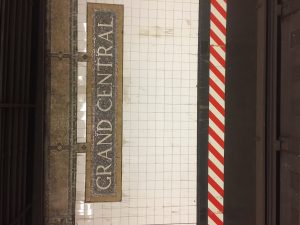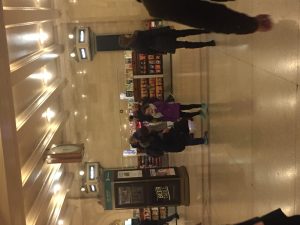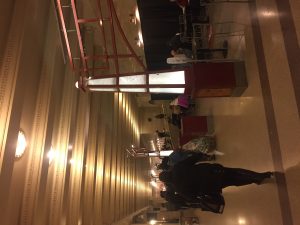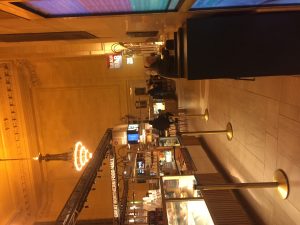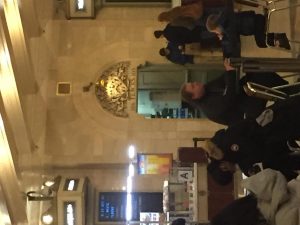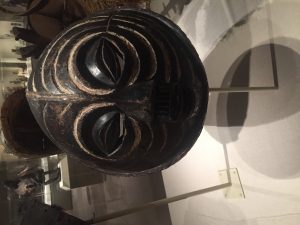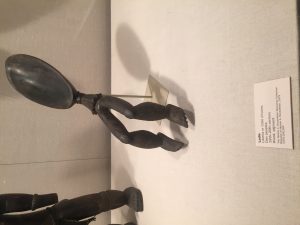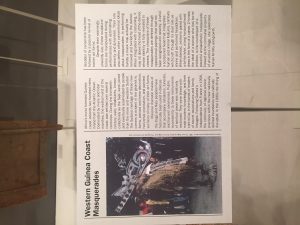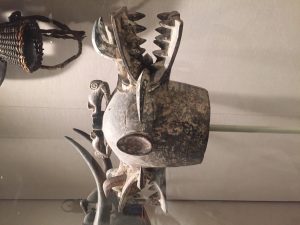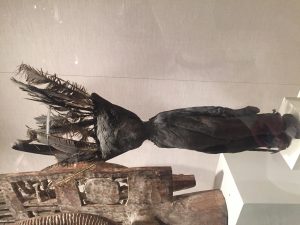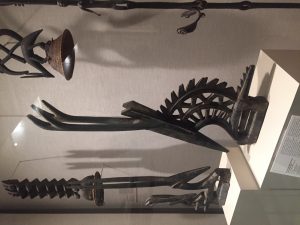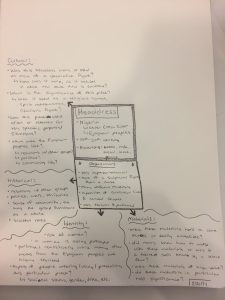When I was very young my dad built a play set that included a swing set for my younger sister and I in our backyard. Somehow from us messing around playing outside and on the swing set so often we developed a game we called “kick swing.” The game could have two or three players and would start with either just me or with my sister and I each on one of the swings and my dad standing in front of us, about ten to fifteen feet away, as our opponent. When the game began my sister and I would begin to swing, attempting to get as much momentum as possible. My dad would then grab a large bouncy ball and throw the ball toward one of us as we were swinging, aiming at our feet and timing the throw so that it would make contact when we were moving forward. There were two ways of scoring a throw, the first being that if he missed the feet of the intended kicker he would then have to retrieve the ball and start again from the beginning and would lose a point, the second being that the kicker who missed the ball would lose a point, making the game more difficult as we as kickers were not responsible for the timing and angle of the throw. When the bouncy ball was aimed and timed correctly one of us on the swings would be able to kick the ball with as much force and momentum as we could. Our goal was to kick the ball with enough force and momentum to launch the ball into the woods behind my dad, and in doing so the kicker would then earn a point and my sister and I would be entertained as my dad was forced to run into the woods to retrieve the flying ball. At this point in the game my dad’s goal however was to catch the ball or at least knock it out of the way somehow as it flew toward the woods, earning himself a point by keeping one of us from reaching our goal. Depending on how competitive we were feeling that day, the game would either be played with my sister and I on a team or each of us competing separately, and in either scenario we would take turns in order kicking the ball toward the woods, assuming we were playing with three players rather than with only my dad and I or only my dad and my sister. When my sister and I chose to play against each other rather than on a team we would change the point system, and each of us would be allowed an extra point for getting the ball farther or higher than the other in a set of turns. The strategy involved on my dad’s side of the game consisted of strategically aiming and angling the ball in a way that would make it difficult for either my sister or me to kick the ball both high enough to go over his head and far enough to make it past him and into the woods behind the yard. He would also have to position himself after throwing the ball in the way that best improved his chances or being able to block the flying ball from disappearing into the woods. On my sister’s and my side of the game we had to try to obtain and hold the highest amount of momentum and speed to put as much force as possible into the kicking or the ball in order to launch it as far and as high as possible, while attempting to remain in the optimal position for kicking the ball in order to not miss the kick.
Month: February 2017
Modified Five Card Draw
Modification of Five Card Draw:
- same rules of five card draw
- draw five cards
- get one chance to replace the desired number of cards
- after that your hand is final
*rule change*
- rather than a specific hand such as the highest pair or a flush winning, the total of the player’s cards added together determines the winner
- aces are worth one, jacks are worth eleven, queens are worth twelve, kings are worth thirteen
- same game, different strategy/ results
- still involves risk because you could draw a card lower than what was in your previous hand or miss out on an opportunity to get a higher card by not taking a chance
The MET Observations
Seminar: Object Information, Observations and Questions
Integrative Seminar 2: Research Topics
1.The History of Tattoo Art
- How did tattoos begin?
- How common were tattoos as a form of identity?
- How did tattoo art become what it is today?
2. The History of Archery as a Sport
- How did archery first transition from necessity to sport?
- When was the sport popularized and recognized in the competitive field?
3. The History of Women in Games
- How prevalent have women been in the games industry in the past?
- The portrayal of women in games
Puzzle Games
The first puzzle game I played for comparison was Old Box on addictinggames.com. In this particular game all of the levels are played within boxes, and within boxes in boxes, the goal being to find a knife in each level in order to cut open the next box to continue on with the game. The game increases in difficulty as the levels progress, adding obstacles between you and the knife such as locked boxes that require finding other objects such as screws, bolts, and gears, to unlock the knife. As you progress new obstacles are added to the same basic functions, such as changing the hue and brightness of a box to match a desired color and unlock an item, spinning a wheel and stopping it in time to allow for it to land on your desired object, finding hidden numbers to enter into a calculator, moving around light bulbs to generate power, and clicking through combinations of doorways to find hidden rooms.
My second game was What’s Inside the Box, also on addictinggames.com. In this game levels are unlocked by solving a variety of different types of puzzles. The types of puzzles include: arranging sliding boxes to reveal a pattern or shape, turning dials to make a boxed- in shape, lighting up hidden lights under moving panels, spelling out words that correlate with the level, completing circles of lights according to specific orders and patterns, and pointing dials in specific directions indicated by letters (N, E, S, W).
In my opinion “What’s Inside the Box” is a better representation of puzzle games than “Old Box” is. In “Old Box” there were puzzles that needed to be solved in order to continue on with the progression of levels in the game, however they often were all the same with a couple of random tasks like the wheel spinning and color picking that were thrown in and only seen once as an added form of variety between the levels. There were often levels in which your only goal would be to repeat the same action of going into a box, retrieving an item, going back out, putting it into a machine to get another item, and repeating in order to finally unlock a box. Aside from those couple different tasks seen once or twice, the tasks were all the same and the game overall was very mindless and at times tedious due to the lack of variety. “What’s Inside the Box” however was consistent enough with its main puzzle themes, connecting them all in a way that made the game very unified, while not being to uninteresting. The levels themselves were also much more challenging both due to the variety of the types of puzzles and the variety in the way that one would go about solving the puzzles due to the multitude of the types of patterns involved in the puzzles. Overall “What’s Inside the Box” was simply much more engaging and required a lot more work to figure out clues and patterns which was much more enjoyable in comparison to the mindless clicking and repetition of “Old Box”.
Bridge 1: Part 2
Upon first entrance, the main concourse of Grand Central Station is an incredibly large, vast space, almost overwhelming with the amount of people rushing around trying to get to where they are meant to be, especially when you yourself don’t know your way around the station. I seemed to be the only one without somewhere else to be. However, with time the space begins to shrink and the people don’t seem to be moving as fast.
The color scheme of Grand Central is quite interesting to me, from a design perspective. All of the cold shiny walls and the main structures such as the information booths and lighting are the same very muted, beige yellow tone. However, the placement of the lighting fixtures saves the space and keeps it very dynamic. Individual chandeliers cast shadows in the large arches of the halls lining the main room, making them seem even larger and more grand. The windows are the most eye catching elements of the station. They are incredibly large and looming, with so much detail in their design. In addition, the blue taken from the outside ties into the turquoise shade of the very ceiling that these large structures point toward. Not many people in Grand Central are looking up, yet the ceiling is quite beautiful. The majority of the ceiling shows off an incredibly large mural of constellations, the color of which matches the walls in keeping with the color scheme, and it is complete with small lights that accentuate the stars of the constellations. The people of Grand Central also lend a hand to the overall muted tonal color scheme. Because it is winter the figures hurrying past are covered from head to toe, most all of them in black, which causes them all to blend together in a sea of travelers. However, upon arriving on the lower level, similarly muted in color and slightly more muted in lighting, one man in particular stood out to me, though he was just as bundled as the rest he was a burst of color in the dulled room, dressed in a bright red coat with a green backpack almost matching in brightness.
Grand Central has a way of being bustling with noise and conversation without being at all too overwhelming. Though everyone is talking and going about their business it is very easy to concentrate on things other than the noise, and to concentrate on particular aspects of the noise such as individual interactions between people passing by. I feel that the whispering gallery accentuates this quality quite well, allowing you to whisper to someone on the other side of the hall and have them hear you clearly amidst the hustle and bustle of the station. Grand Central is also home to a wide variety of smells, much like the city itself. Once in the back areas of the station, such as the shops and the lower dining level, your sense of smell is overloaded. The shopping area smells of everything from crisp book pages to a variety of lotions, changing with almost every step. Once on the lower level of the station you are immersed in a plethora of different types of food, and everything from pretzel and lemonade stands to bakeries take over your senses.
The designer of Grand Central Station had to have put a lot of research into the layout of the area. The way that Grand Central is set up is incredibly efficient. The main concourse shows off how grand the station truly is, drawing you in with its lights and liveliness. Research must also have been done on the area and what most people would be using the station for, because the platforms are very clearly labeled and easily accessible, yet set up in order to be completely out of the way and can easily be ignored by those simply there to enjoy some shopping and hanging out. The way the rest of the station is played out pulls you through the patterns of hallways, the station seeming to only get bigger as you more through it going on and on. The levels loop you around the shops and restaurants in order to ensure you don’t miss the chance to experience it all. The way the light changes is very well thought out and planned. When I visited the station it was just starting to get dark outside, and though the sky changed steadily as it does when night begins to fall, the station never seemed to change it’s level of light, despite having large windows, and I barely noticed the change, which caused me to lose sense of time, as if the station were in its own little bubble. Thinking deeply about things such as the design of the layout, the subtle changes in lighting, and the types of people accessing the station at any given time has allowed me to gain more appreciation for Grand Central Station. The design decisions and research that have gone into the curation of this place are extensive and the station achieves both its purpose, to provide a place of transportation for New Yorkers and its visitors, and multitasking as a social hub for those wishing to escape into something different.
The Core Mechanic of BS
BS is a card game, of which the core mechanic is the quick placement of cards onto a pile in the center of its players. The goal of the game is to get rid of all of your cards. The full deck is dealt out evenly amongst however many players there are, which from the start can make the goal of the game much easier or harder to reach. The player with the ace of spades typically starts, placing this card in the center of the circle of players. The next player, going around the circle in order, must place down twos, the nest threes, the next fours, and so on and so forth. The player can set down one or more of their designated card but must announce the amount of cards they are laying down along with their number as they do so. This is to ensure that all players can fully assess what is happening, and provides an opportunity for a slip up on the part of the card holder, as they could accidentally say the wrong card type or number and give away the truth. This brings me to another core concept of the game, lying. Because there are only so many of each type of card, and because passing or skipping one’s turn is not allowed, the wild card in this game is the allowance of all players at any time to completely lie about what they are in fact putting down. For example, if it were my turn to place down eights, and I had none, I could put down a four and a queen and say “two eights.” Similarly, if I did happen to have an eight, but I wanted to get rid of as many cards as I could, as that is the object of the game, I could put down said eight along with a three and a six, claiming that I was putting down three eights. In the time between the point at which my card(s) touch(es) the pile and the point at which the next player’s card(s) touch(es) the pile, any player is allowed to call my bluff and shout “bs.” My cards would then be revealed, and because I lied I would have to collect all of the cards in the pile and add them to my deck, putting me at a disadvantage. However if in the same situation I had not lied, and instead put down my single eight, the player who attempted to call my bluff would be proven wrong and they would be forced to collect all of the cards in the pile. In order to give the players an option to assess their opponents’ decisions, if a player has lied about their hand, they must say “peanut butter” once the next player has laid their card down, marking the first player safe from being called out. Therefore, players have the opportunity to guess the probability of each of their opponents’ turns being truthful or lies. Because it is highly likely that each player will be forced to lie at some point in time, given the card count, especially if there are more players, and because the object is to get rid of cards quickly, it is more probable that a player will lie, giving their opponents a sense of security in calling them out, however as the game progresses and it becomes more likely that players are lying, it also becomes much riskier to call someone out as the punishment is a large pile and the rest of the players often have an increasingly low amount of cards. Though the core mechanic of this game is the simple placing down of cards, the strategy and decision-making behind each player’s placements and the actions toward other players make this a high risk and often very complex game.
Grand Central Notes
One of the first things that struck me on my visit to Grand Central was the lighting. Though the ceiling consisted only of a few small lights scattered throughout the mural of constellations, the area was still very well-lit with multiple different types of lighting. Globes of lights lined the arched openings of the walls and smaller very uniform lights lined their tops, in a perfect row wrapping around the entire open area. Each information and ticket center is equipped with its own set of lights and accompanied by a large lit information board. When I went it was dark, so the windows did not provide light, but to me they are still the most magnificent addition, as they catch your eye right away and help to lead it up to the decorated ceiling. People are rushing past and everyone seems to know where they are going in the hub of the station, hurrying to get to where they are going or to find out more information. Though most everyone is participating in a conversation of their own, it somehow is not overwhelmingly loud and not very hard to ignore. Most everyone is dressed in black heavy winter attire, which made one man in particular dressed in bright red and green stand out to me. I ventured down into the lower level, where the noise was much more concentrated, yet still not the most prominent, the most prominent was the smell. Restaurants and dining areas line all four walls and create a mix of smells from coffee to burgers and fries. The arches on the lower level are adorned with eye-catching sculptural elements. The upper area is full of shops, and is very bright, each shop seeming very inviting. One area of the station was designated to selling books, a simple open area with shelves people could walk through, that was quieter than the rest and smelled of book pages. The lighting of grand central station must have been researched a lot, due to its success and ability to seamlessly transition from night into day even with such large windows, something that would usually be a dead giveaway. The layout must have been researched in detail as well, as it is each to find platforms yet they are out of the way of those in the area for other reasons, as to not be a distraction. The entirety of the layout is well designed in that everything circulates and brings you around to different areas of interest, allowing the station to be a place easy to spend a lot of time in.
